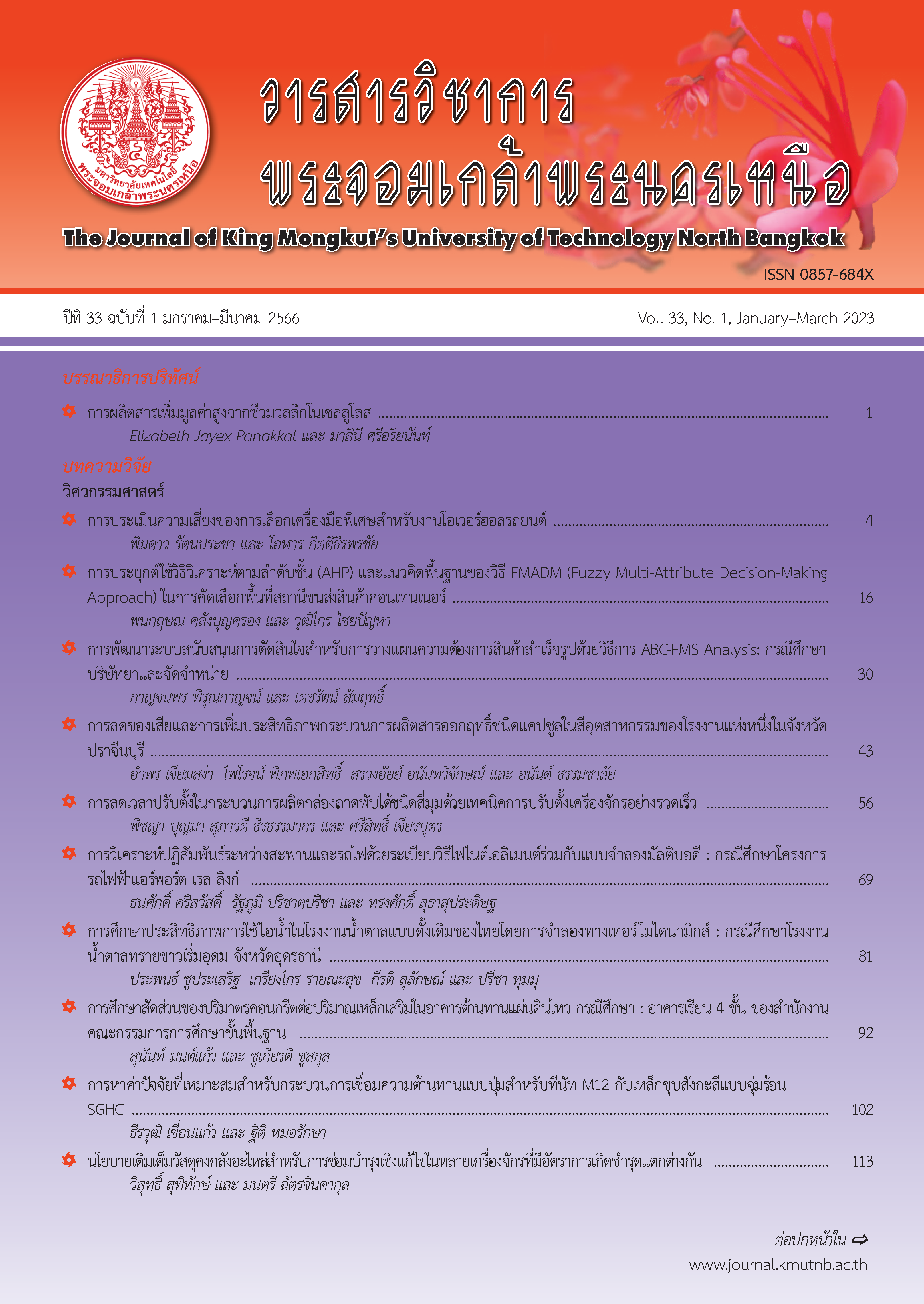การหาค่าปัจจัยที่เหมาะสมสำหรับกระบวนการเชื่อมความต้านทานแบบปุ่มสำหรับทีนัท M12 กับเหล็กชุบสังกะสีแบบจุ่มร้อน SGHC
Main Article Content
บทคัดย่อ
งานวิจัยนี้มีวัตถุประสงค์เพื่อหาค่าปัจจัยที่เหมาะสมที่มีอิทธิพลต่อค่าแรงกดสูงสุด (Maximum Compression Force)สำหรับกระบวนการเชื่อมความต้านทานแบบปุ่ม (Projection Spot Welding) สำหรับทีนัท M12 กับเหล็กชุบสังกะสีแบบจุ่มร้อน SGHC โดยใช้เทคนิคการวิธีการออกแบบการทดลองแฟคเตอเรียลเต็มรูป 23 (Full Factorial Experiment) ที่ระดับความเชื่อมั่น 95% และใช้ฟังก์ชันความพึงพอใจ (Desirability Function) เป็นเครื่องมือเพื่อหาค่าที่เหมาะสมของปัจจัย สำหรับปัจจัยที่ทำการศึกษามี 3 ปัจจัย ได้แก่ แรงกดหัวอิเล็คโทรด กระแสไฟฟ้าเชื่อม และเวลาเชื่อม ซึ่งผลการศึกษาพบว่าค่าระดับของปัจจัยที่เหมาะสมที่ทำให้ค่าแรงกดสูงสุด คือ แรงกดหัวอิเล็คโทรด 7.11 กิโลนิวตัน กระแสไฟฟ้าเชื่อม 11,500 แอมแปร์ และเวลาเชื่อม 15 ไซเคิล (300 มิลลิวินาที) โดยค่าเฉลี่ยค่าแรงกดสูงสุดเท่ากับ 8,766 นิวตัน ซึ่งผ่านตามเกณฑ์มาตรฐาน TSB 1503G นอกจากนี้ยังสามารถลดต้นทุนการผลิตได้ปีละ 110,880 บาท คิดเป็น 0.42% ของต้นทุนสินค้าประกอบหลัก (Assembly Part) และคงสภาพการจ้างงานของพนักงานเดิมโดยไม่เลิกจ้างจำนวน 1 คน โดยวิธีการเพิ่มภาระงานให้ครบเวลาการทำงานมาตรฐาน 8 ชั่วโมงต่อวัน
Article Details

อนุญาตภายใต้เงื่อนไข Creative Commons Attribution-NonCommercial-NoDerivatives 4.0 International License.
บทความที่ลงตีพิมพ์เป็นข้อคิดเห็นของผู้เขียนเท่านั้น
ผู้เขียนจะต้องเป็นผู้รับผิดชอบต่อผลทางกฎหมายใดๆ ที่อาจเกิดขึ้นจากบทความนั้น
เอกสารอ้างอิง
S. Chanthapong and C. Osatis. (2020, December). Turn over the Thai automotive crisis by enhancing labor skills. Bank of Thailand. Bangkok, Thailand (in Thai) [Online]. Available:https:// www.bot. or.th/Thai/ResearchAndPublications/articles/ Pages/Article_15Sep2020.asp
S. Tamthai, “The severity of the COVID-19 crisis affecting the manufacturing sector,” The Office of Industrial Economics, Bangkok, Thailand, November 2020 (in Thai).
Y. Butsa, “A study of localization automotive parts from japan to Thailand,” M.S. thesis, Department of Logistics and Supply Chain Management, Faculty of Logistics, Burapha University, Chon Buri, 2016 (in Thai).
H. Zhang and J. Senkara, Resistance Welding Fundamentals and Applications, 2nd ed. New York: Taylor & Francis Group, Inc. 2001.
T. Khuenkaew, “Resistance spot welding of SUS316L and SUS425 stainless steels,” D.Eng dissertation, Department of Industrial Engineering, Faculty of Engineering, King Mongkut's Institute of Technology Ladkrabang, Bangkok, 2019 (in Thai).
P. D. Enrique, H. Al Momani, C. DiGiovanni, Z. Jiao, K. R. Chan, and N. Y. Zhou, “Evaluation of electrode degradation and projection weld strength in the joining of steel nuts to galvanized advanced high strength steel,” Journal of Manufacturing Science and Engineering, vol. 141, no. 10, pp. 1045011–1045018, 2019.
F. Valdir, S. Danilo, F. Gilmar, and R. Fernando, “Inspection of projection welded automotive nuts through B-scan ultrasonic acoustic imaging,” presented at the 18th World Conference on Nondestructive Testing, Durban, South Africa, April 16–20, 2012.
Y. Janthong and K. Kanlayasiri, “Optimization on resistance projection welding variables for M8 nuts and SPHC270 hot-rolled mild steel plates welding,” presented at the IE Network Conference 2013, Chon Buri, Thailand, October 16–18, 2013 (in Thai).
Z. Mikno, M. Stepien, and B. Grzesik, “Optimization of resistance welding by using electric servo actuator,” Welding in the World, vol. 61, no. 2, pp. 453–462, 2017.
Z. Mikno, “Projection welding of nuts involving the use of electromechanical and pneumatic electrode force,” The International Journal of Advanced Manufacturing Technology, vol. 99, pp. 1405–1425, 2018.
W. Boonchouytan, R. Burapa, and W. Cheewawuttipong, “Effects of friction welding dissimilar joint to metallurgy and mechanical properties between aluminum casting semi-solid metal 356 and 7075 with copper interlayer on welded,” The Journal of KMUTNB, vol. 30, no. 3, pp. 465–480, 2020 (in Thai).
P. Chutima, Design of Experiments in Engineering, Chulalongkorn University Press, Bangkok, 2002 (in Thai).
P. Lalitaporn, Production Planning and Control, SE-Education public company limited, Bangkok, 2013 (in Thai).

